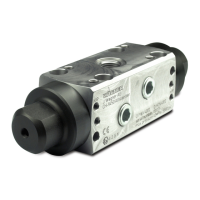13
VERSION 06/2018
ORDER NUMBER DOC 2343275
Several liquids have a high expansion coecient. In some cases, their volume can rise with
consequent damage to pipes, ttings, etc. and cause uid leakage.
When the pump sucks liquid from a closed tank, ensure that air or a suitable gas can
enter the tank. Thus a negative pressure is avoided. The vacuum could implode the tank
(squeeze) and can cause it to break. The tank would leak and the liquid would ow out.
The pressure created by the pump is a multiplication of the inlet air pressure.
4.2.5 CLEANING AND FLUSHING
Hazard due to cleaning and ushing!
Explosion hazard and damage to the device.
Preference should be given to non-ignitable cleaning and ushing agents.
When carrying out cleaning work with ammable cleaning agents, make sure
that all equipment and resources (e.g., collection tank, funnel, transport cart) are
conductive or static dissipative and grounded.
Observe the specications of the lacquer manufacturer.
Ensure that the ash point of the cleaning agent is at least 15 K above the ambient
temperature or that cleaning is undertaken at a cleaning station with technical
ventilation.
Never use chloride or halogenated solvents (such as trichloroethane and methylene
chloride) with units containing aluminium or galvanized and zinc-plated parts. They
may react chemically thus producing an explosion danger.
Take measures for workplace safety (see Chapter 4.1.2).
When commissioning or emptying the device, please note that:
– depending upon the coating product used,
– depending on the flushing agent (solvent) used.
an explosive mixture may temporarily exist inside the lines and items of equipment.
Only electrically conductive tanks may be used for cleaning and ushing agents.
The tanks must be grounded.
An explosive gas/air mixture forms in closed tanks.
Never spray into a closed tank when using solvents for ushing.
External Cleaning
When cleaning the exterior of the device or its parts, also observe the following:
Relieve the pressure from the device.
De-energize the device electrically.
Disconnect the pneumatic supply line.
Use only moistened cloths and brushes. Never use abrasive agents or hard objects
and never spray cleaning agents with a gun. Cleaning the device must not damage
it in any way.
Ensure that no electric component is cleaned with or immersed into solvent.

